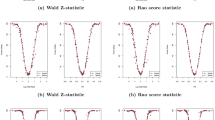Abstract
In a 2×2 table, phi measures the strength of the relationship and relative improvement over chance (RIOC) measures the predictive efficiency. A simplified formula for RIOC is derived. From the linkage between RIOC and the adjusted standardized residual, the variance of RIOC is calculated, thereby allowing its statistical significance to be tested. A disadvantage of phi is that its maximum value can be less than 1. A corrected phi correlation, obtained by dividing phi by the maximum possible phi, is shown to be mathematically identical to RIOC. Hence, there is a linkage between the percentage of correct predictions and the percentage of variance explained. RIOC is unchanged even when the social costs and benefits of the different outcomes are differentially weighted. RIOC is also mathematically identical to a corrected kappa calculated in a similar fashion to the corrected phi. Therefore, RIQC has distinct advantages over phi and kappa.
Similar content being viewed by others
References
Blumstein, A., Cohen, J., Roth, J. A., and Visher, C. A. (1986).Criminal Careers and “Career Criminals,” National Academy Press, Washington, D.C.
Blumstein, A., Farrington, D. P., and Moitra, S. (1985). Delinquency careers: Innocents, desisters, and persisters. In Tonry, M., and Morris, N. (eds.),Crime and Justice, Vol. 6, University of Chicago Press, Chicago, pp. 187–219.
Bursik, R. J. (1980). The dynamics of specialization in juvenile offenses.Soc. Forces 58: 851–864.
Cohen, J. (1960). A coefficient of agreement for nominal scales.Educ. Psychol. Measure. 20: 37–46.
Conger, A. J., and Ward, D. G. (1984). Agreement among 2 by 2 agreement indices.Educ. Psychol. Measure. 44: 301–314.
Copas, J., and Loeber, R. (1989). The statistical properties of the index: Relative improvement over chance (RIOC).Brit. J. of Math, and Stat. Psychology (in press).
Copas, J. B., and Tarling, R. (1986). Some methodological issues in making predictions. In Blumstein, A., Cohen, J., Roth, J. A., and Visher, C. A. (eds.),Criminal Careers and “Career Criminals,” National Academy Press, Washington, D.C., pp. 291–313.
Cureton, E. E. (1959). Note on (φ/φ) max.Psychometrika 24: 89–91.
Edwards, A. W. F. (1963). The measure of association in a 2×2 table.J. Roy. Stat. Soc. Ser. A 126: 109–114.
Farrington, D. P. (1987). Predicting individual crime rates. In Gottfredson, D. M., and Tonry, M. (eds.),Prediction and Classification: Criminal Justice Decision Making, University of Chicago Press, Chicago, pp. 53–101.
Farrington, D. P., and Tarling, R. (1985a). Criminological prediction: An introduction. In Farrington, D. P., and Tarling, R. (eds.),Prediction in Criminology, State University of New York Press, Albany, New York, pp. 2–33.
Farrington, D. P., and Tarling, R. (1985b). Criminological prediction: The way forward. In Farrington, D. P., and Tarling, R. (eds.),Prediction in Criminology, State University of New York Press, Albany, pp. 258–269.
Haberman, S. J. (1973). The analysis of residuals in cross-classified tables.Biometrics 29: 205–220.
Hays, W. L. (1963).Statistics, Holt, Rinehart and Winston, New York.
Loeber, R., and Dishion, T. (1983). Early predictors of male delinquency: A review.Psychol. Bull. 94: 68–99.
Ohlin, L. E., and Duncan, O. D. (1949). The efficiency of prediction in criminology.Am. J. Soc. 54: 441–451.
Reynolds, H. T. (1977).The Analysis of Cross-Classifications, Free Press, New York.
Roff, J. D. (1986). Identification of boys at high risk for delinquency.Psych. Rep. 58: 615–618.
Tolan, P. H. (1987). Implications of age of onset for delinquency risk.J. Abnorm. Child Psychol. 15: 47–65.
Wilson, B. J., and Reichmuth, M. (1985). Early-screening programs: When is predictive accuracy sufficient?Learn. Disab. Q. 8: 182–188.
Author information
Authors and Affiliations
Rights and permissions
About this article
Cite this article
Farrington, D.P., Loeber, R. Relative improvement over chance (RIOC) and phi as measures of predictive efficiency and strength of association in 2×2 tables. J Quant Criminol 5, 201–213 (1989). https://doi.org/10.1007/BF01062737
Issue Date:
DOI: https://doi.org/10.1007/BF01062737




